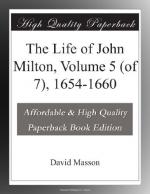time involve them in inconveniences with their Dutch
neighbours; but their dissensions were chiefly with
each other, or domestically within each colony.
The harsh proceedings in Massachusetts and elsewhere
against Baptists and other Sectaries gave some colour
to Roger Williams’s assertion that, in the matter
of religious toleration, New England was becoming
old while Old England was becoming new; and, as soon
as Quakerism had broken out in New England and Quakers
had appeared there (1656), it became evident that
there would be even less mercy for that sect in New
England than on the other side of the Atlantic.
Nevertheless, with their zealous Puritanism, their
energy and industry, and the abilities of their Bradfords,
Bradstreets, Winslows, Winthrops, Standishes, Endicotts,
Hayneses, Hopkinses, Newmans, Williamses, and other
prominent governors or assistant-governors, the Confederacy
and the Plantations went on prosperously towards their
ultimate, though yet unforeseen, destiny in the formation
of the United States. Cromwell, indeed, had a
scheme which would have stopped that issue. He
had a scheme for fetching all the Puritans of New
England back and planting them splendidly in Ireland.
Communications on the subject had passed as early
as 1651, when Ireland had been just reconquered; but
naturally without effect. The New Englanders
were not then too numerous perhaps to have been transported
to Ireland bodily; but, as one of their historians
says, “they had taken root.” Their
increase, however, for more than a century thenceforward
was to be mainly within themselves, for new arrivals
from England had become scarce.[1] II. OTHER
COLONIES AND SETTLEMENTS IN NORTH AMERICA. These
too went on very much at their own will, though not
quite unnoticed. Virginia, dating from 1608,
and Maryland, dating from 1634, continued to
be the favourite colonies for Royalist settlers, Anglican
or Roman Catholic; but there had been recent additions
of English Puritans, and of transported Scottish prisoners
of war, to the population of Virginia, and the connexions
with the mother-country had remained unbroken.
There were commercial regulations about both Colonies
by the English Council, and grants of passes to them.
Canada and the other regions about the St. Lawrence,
the possession of which had been contested by the
English and the French in the reign of Charles I,
had lapsed long ago into the hands of the French; but
Major Sedgwick had wrested back for Cromwell, in 1654,
the peninsula then called Acadie, but now Nova
Scotia, being part of the territory that had been
granted under that name by Charles to his Scottish
Secretary, the Earl of Stirling, and had been colonised
by Scots, to some extent, from 1625 onwards.
Off the mainland, Newfoundland, which had contained
an English fishing population for at least twenty
years, was not neglected; and, beyond the bounds of
any of the North-American Colonies or Plantations that
were definitely named and recognised, there may have




